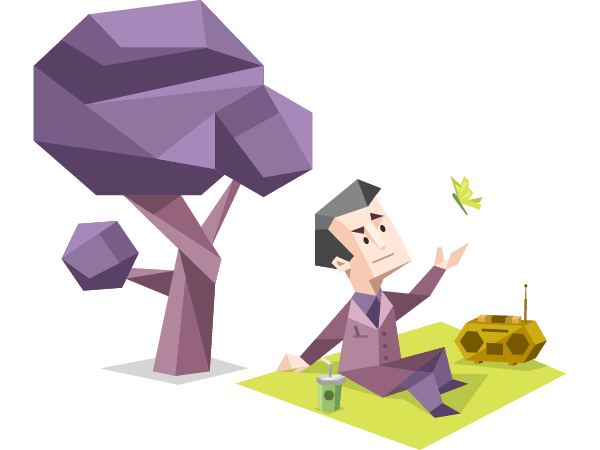AnonymousEntrepreneur

Mind
This trait determines how we interact with our environment.
Extraverted individuals
prefer group activities and get energized by social interaction. They
tend to be more enthusiastic and more easily excited than introverts.
Read more
Energy
This trait shows where we direct our mental energy.
Observant individuals are
highly practical, pragmatic and down-to-earth. They tend to have strong
habits and focus on what is happening or has already happened.
Read more
Nature
This trait determines how we make decisions and cope with emotions.
Thinking individuals focus
on objectivity and rationality, prioritizing logic over emotions. They
tend to hide their feelings and see efficiency as more important than
cooperation.
Read more
Tactics
This trait reflects our approach to work, planning and decision-making.
Prospecting individuals are
very good at improvising and spotting opportunities. They tend to be
flexible, relaxed nonconformists who prefer keeping their options open.
Read more
Identity
This trait underpins all others, showing how confident we are in our abilities and decisions.
Assertive individuals are
self-assured, even-tempered and resistant to stress. They refuse to
worry too much and do not push themselves too hard when it comes to
achieving goals.
Read more
Mind: Introverted vs. Extraverted
It is safe to say that Extraversion and Introversion are probably
the oldest notions in the history of personality theories. It has long
been observed that some people are expressive, outgoing and comfortable
in interacting with their surroundings – while others are reserved,
quiet and more comfortable alone. It is as if the former sincerely enjoy
engaging with the external world and recharge by communicating with
other people, and the latter prefer to rely on themselves and their own
inner world instead of seeking stimulation from the outside. We focus on
these differences in our first scale, which we call Mind – it
determines how we see and approach the outside world, including people,
objects and activities within it.
While Introversion and Extraversion are often used in lieu of social aptitude, this scale involves more than just being outgoing and social – although social skills form part of it. In a broader way, the Mind scale determines the degree of interaction with the outer world; how socially one behaves is just a part of that. In a sense, this scale is a contrast of the quantity and intensity of an experience and its quality or depth.

 People who are considered Extraverts (E) in our model are not as sensitive to outer stimuli and need to seek them
out in order to gain a kind of functional equilibrium and to perform
well. Introverts (I), on the other hand, are more sensitive and need to escape the
same stimuli in order to be more functional. Unlike Extraverts,
Introverts can quickly exhaust their mental energy reserves, and they
will only tolerate such situations so long before they yearn for
solitude and quiet.
People who are considered Extraverts (E) in our model are not as sensitive to outer stimuli and need to seek them
out in order to gain a kind of functional equilibrium and to perform
well. Introverts (I), on the other hand, are more sensitive and need to escape the
same stimuli in order to be more functional. Unlike Extraverts,
Introverts can quickly exhaust their mental energy reserves, and they
will only tolerate such situations so long before they yearn for
solitude and quiet.
Let’s consider a couple of practical examples. Our research shows that Introverts are significantly more likely to report being sensitive to noise and bright colors, and they also strongly prefer simplicity and minimalism in their environment (especially if their Introversion is coupled with the Thinking trait). Likewise, they do not seek or require much external stimulation – while communicating with other people is the most obvious example of such stimulation, this concept also extends to things like hobbies, political attitudes and even eating or drinking habits. For instance, Introverts are more likely to dislike coffee and energy drinks.
On the opposite side of the spectrum, Extraverts are more interested in engaging the environment – people and objects around them – and they need feedback as well. They are more energetic and willing to take the lead in many situations, especially social ones, and they enjoy pushing limits and challenging both themselves and those around them. People with Extraverted personality types are also more likely to feel that they can handle any challenges life throws their way. Obviously, whether that turns out to be true or not depends on many other circumstances, but generally speaking, Extraverts tend to be much more proactive in experiencing (and relying on) the world around them.
Finally, it is important to point out that the Mind scale does not determine how introspective or reflective we are – even though it may be tempting to confuse the two. There are introspective Extraverts and non-introspective Introverts. Ultimately, this scale is about how much stimulation we require and can absorb from our environment, not about what happens in our minds afterwards.
While Introversion and Extraversion are often used in lieu of social aptitude, this scale involves more than just being outgoing and social – although social skills form part of it. In a broader way, the Mind scale determines the degree of interaction with the outer world; how socially one behaves is just a part of that. In a sense, this scale is a contrast of the quantity and intensity of an experience and its quality or depth.


Let’s consider a couple of practical examples. Our research shows that Introverts are significantly more likely to report being sensitive to noise and bright colors, and they also strongly prefer simplicity and minimalism in their environment (especially if their Introversion is coupled with the Thinking trait). Likewise, they do not seek or require much external stimulation – while communicating with other people is the most obvious example of such stimulation, this concept also extends to things like hobbies, political attitudes and even eating or drinking habits. For instance, Introverts are more likely to dislike coffee and energy drinks.
On the opposite side of the spectrum, Extraverts are more interested in engaging the environment – people and objects around them – and they need feedback as well. They are more energetic and willing to take the lead in many situations, especially social ones, and they enjoy pushing limits and challenging both themselves and those around them. People with Extraverted personality types are also more likely to feel that they can handle any challenges life throws their way. Obviously, whether that turns out to be true or not depends on many other circumstances, but generally speaking, Extraverts tend to be much more proactive in experiencing (and relying on) the world around them.
Finally, it is important to point out that the Mind scale does not determine how introspective or reflective we are – even though it may be tempting to confuse the two. There are introspective Extraverts and non-introspective Introverts. Ultimately, this scale is about how much stimulation we require and can absorb from our environment, not about what happens in our minds afterwards.

No comments:
Post a Comment